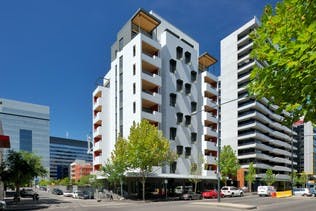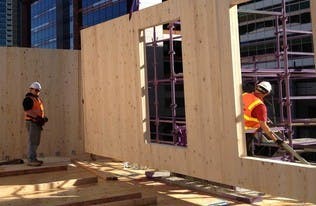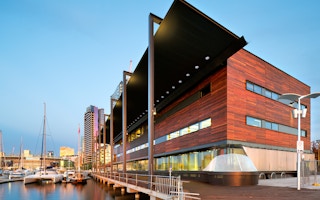The idea of using wood for building walls in Singapore must have sounded outlandish to the authorities back in 2012. After all, wood is flammable and the country requires that the structural elements of buildings be fire-proof.
But this year, the Singapore Civil Defence Force (SCDF) officially revised its fire code to allow the use of Cross Laminated Timber (CLT) for structural components in buildings after a thorough safety assessment.
This change came about thanks to the efforts of international property and infrastructure firm Lend Lease, which has been leading efforts to promote the use of CLT technology in Singapore as a cost-saving, environmentally-sustainable building system.
Lend Lease noted that the use of CLT technology will reduce reliance on foreign manpower and imports of sand and aggregate, which is good news for Singapore’s construction industry.
Over the years, the government has been cutting back on foreign manpower quotas to soothe the growing friction between locals and foreigners in the densely-populated city. The price of sand has also jumped as several Southeast Asia countries have banned the export of sand and granite to Singapore, citing environmental degradation caused by sand extraction.
Lend Lease in Australia had done three years of due diligence on CLT technology before embarking on its Forté project, comprising 23 CLT apartments in Melbourne, which was completed in 2013. Forté was completed 30 per cent faster than if reinforced concrete had been used.
Mann Young, Head of CLT Business (Asia) for Lend Lease, shared with Eco-Business in a recent interview that the SCDF and the Building and Construction Authority (BCA) granted their in-principle acceptance of CLT technology mid-last year after 18 months of discussions, presentations and overseas study trips.
But even then, they stipulated that CLT buildings could not exceed four storeys. Eventually, the height limit for CLT buildings was increased last November to a maximum of 24 metres, or six or seven storeys, after authorities conducted a further European study tour of CLT buildings.
Earlier this month, Singapore’s Economic Development Board (EDB) launched a new platform called the ‘Pre-Project Innovation Consortium’ to promote integrative design and enable building industry players to collaborate on sustainable buildings early in the design stage.
Under this initiative, Lend Lease will be leading a consortium and plans are underway to test-bed the use of CLT in Singapore.
Properties of Cross Laminated Timber

Forté is Australia’s first timber high rise apartment building, and the tallest in the world.
CLT is produced by pressure-gluing three, five, seven or 11 layers of timber such that the wood grain of each layer is at 90 degrees to that of the next layer’s, distributing weight in both directions.
The resulting CLT panel has a load-bearing capacity similar to that of concrete, but is 80 per cent lighter, so the foundation for a building constructed with CLT will not have to bear as much weight. The foundation for a CLT building in Singapore will remain constructed from concrete to prevent termite infestation.
The stacked layers of CLT also result in a predictable and slower rate of burning, “like charcoal rather than a box of matches, charring at 0.7 millimetres per minute”, noted Young. One test that demonstrated CLT’s “better-than-concrete integrity” and fire-resistance involves having a 1000°C fire burning away on one side of a 5-layer thick CLT panel.
When the fire had burnt the panel down to three layers, the temperature on the opposite side of the panel was measured at 24 to 25 degrees Celsius – a testament to its excellent thermal performance, which will help reduce the energy needed for cooling buildings in tropical Singapore.
Timber is renewable and requires the lowest energy and water consumption of any building material, which in turn, reduces the amount of deliveries needed to the worksite. The sustainability benefits of CLT include being recyclable after the building is demolished.
Young said that a study by RMIT University in Australia conducted for its Forté project found that even though the CLT is imported, the Forté building has lower environmental impact across all the assessed categories, including lower impact for materials and transport when compared to traditional concrete structure.
“
I see the CLT system as a game changer for Singapore. The timing is perfect for here, now.
Mann Young, Head of CLT Business for Asia, Lend Lease
Rethinking design
Young cautioned that “if CLT technology is thought of as just a material replacement, it will fail…. it is changing the way we design and construct buildings from first principle.”
Simply put, building a room traditionally required four concrete columns, four beams and non-structural walls. With CLT, only four load-bearing, structural walls are needed. This eliminates the need for formwork, scaffolding and the waiting time required for concrete to cure. Sub-contractors can begin to install their respective ceiling services, wall and floor finishes, improving overall efficiency and productivity.
Using CLT technology thus requires spending more time upfront on the design and drawing phases of building development because the CLT panels are cut to specification in factories, down to the openings and slots for water pipes and wiring, before being assembled on-site “just like Lego pieces”.

Construction of Cross Laminated Timber for Lend Lease’s Forte building in Melbourne, Australia.
This allows faster construction with fewer on-site staff, which indirectly reduces the likelihood of workplace accidents and directly reduces the waste, noise and dust pollution on the surrounding community.
Young observed that the entire design and building process in Singapore tends to happen in silos, adding that there are industry challenges in getting “ upfront collaboration and integration” between architects, engineers, consultants, builders and facilities managers. Yet, such integration is needed to minimise waste and optimise design when using CLT.
He said: “The challenge for us now is to get architects and consultants locally to understand and be comfortable enough to design buildings using this technology that is new to them.”
When asked why he advocates the use of CLT since Lend Lease is not a supplier of the material, Young explained: “From an investor point of view, using CLT makes sense for Lend Lease. Land cost in Singapore is about two-thirds of development cost so if we can build safer and smarter with less manual labour on site, we can achieve an improved internal rate of return. Timber finishes also look great, produce a sense of warmth and has numerous sustainability benefits.
“I see the CLT system as a game changer for Singapore. The timing is perfect for here, now,” he added.


















